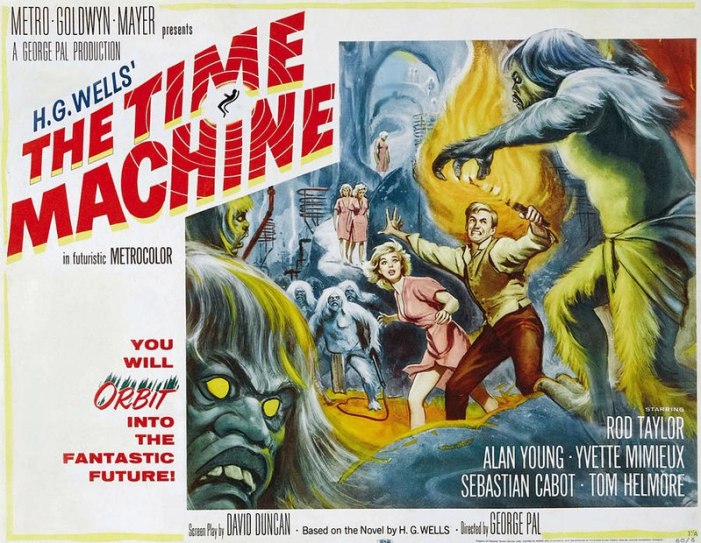
An H. G. Wells (1866-1946) adaptation here from George Pal, the 1960 sci-fi effort featured impressive special effects and some challenging time travel concepts.
The Time Machine
Unlike many other sci-fi films of its era (such as The Angry Red Planet—also from 1960), Pal’s film has excellent production values.
But it all started with Wells’ novella, first published in 1895. It was a significant work in the development of science fiction. As was this subsequent film 65 years later.
David Duncan adapted the work for the screenplay, he was a prolific sci-fi screenplay writer for many B-movies.
Australian actor Rod Taylor (1930-2015) starred in this one as genius scientist H. George Wells.
His commitment to the part and natural ease as an actor really paid dividends. He did a terrific job with material that may have come across as daft.
Set on January 5th 1900, four friends arrive at a house to find their mate H. George Wells is missing. They hang around for a bit when suddenly he arrives unkempt and knackered.
He’s able to recount an impossible, incredible tale to them about his recent time travelling antics. And so, he begins to tell his story.
Cue flashback! We find Wells discussing time as a “fourth dimension”. Kind of in a Flatland: A Romance of Many Dimensions type consideration.
He shows his friends a small time machine model, which they’re a bit skeptical of. Unbeknownst to them, he has a proper full scale majigger readily available.
And after they all depart for the evening, Wells takes it upon himself to test out his contraption.
At first he’s tentative, travelling to 1917 and then 1940—observing the change of businesses and fashions in the London street ahead of him.
He stops in 1940 for a look around. Bad timing, you genius halfwit, you’re amidst the Blitz!
Shocked by what he finds, he returns to his machine, advances forward, and stops in 1966. Again, he immediately has to leg it into hiding. There’s nuclear fallout!
And that causes volcanic eruptions, with Wells once again escaping to his time machine. Unfortunately, he still becomes encased around the hardened volcanic lava.
He blasts ahead further into the future until the lava disintegrates—it’s October 12th, 802,701.
This is where the The Time Machine’s themes start to get increasingly unsettling, as H.G. Wells’ novella explores the concept of humanity fading away.
Wells (our protagonist) goes for a wander in what appears to be a delightful future, with lush countryside and an abundance of wildlife.
He comes across the descendants of humans, with the passive and naive Eloi first. They’re emotionally and intellectually stunted and the pray of the Morlocks.
These green sorts are aggressive and feed off the Eloi, using sirens to herd them into their factory.
Wells hits it off with Weena (American actress Yvette Mimieux—only 17 at the time of shooting, turning 18 during the production), whom he finds more intellectually curious than her rather dimwitted peers.
She leads him to a museum, with ageing technology that fill in the gaps about what’s happened to humanity.
Due to a 326 year war in the distant past, some humans went underground to hide from toxic fumes—others remain on the surface.
Wells realised that was the point of speciation for humans (where populations can evolve to become separate species). With the Morlocks emerging as the dominant sorts.
As he battles into the caverns to help Weena and the other Eloi, doing battle in the process, he finally inspires them to defend their species.
That, of course, hints at significant and further strife between the Eloi and Morlocks.
However, Wells is separated from Weena and in a bid for survival realises he must return to 1900. Cue some excellent practical effects for 1960.
But the film ends on a romantic note, with Wells informing his friends he’s off to bed (how terribly English).
However, when they hear a noise they walk go to investigate.
They deduce that Wells has moved the time machine slightly, so he can head back in time and to the point where he’s not inside the Morlock’s cave. And rekindle his romance with Weena. Swoon. Flutter eyelids.
And there we go, a classic of Hollywood’s golden years.
To this day, we have to say it’s very impressive. Taylor’s performance is essential, as he really sells the believability factor.
Wells is a likeable and noble protagonist. He shows progressive views in science and education, rounding on the Eloi when he realises they’ve allowed their libraries to turn to dust.
But when, in disgust, he decides to flee the land, he comes to save them upon realising the Morlocks are pure evil.
He also boasts an impressively robust hairdo throughout the film. It’s immaculate and doesn’t move, no matter what happens to him. Good man!
For the rest of the cast, Yvette Mimieux’s young age left her inexperienced during the early stages of production.
Pal decided to go back and reshoot early scenes, as she was able to rapidly build on her performance.
But it’s really the special effects that dominate the show. We can still marvel at how the practical effects merge with stop-motion animation.
There’s a nostalgic element for us. We watched the film regularly in the early 1990s. So, that adds to the appeal.
But we can recognise a well made film when we see one. And Pal’s efforts are to be commended—his work on The Time Machine left a big impact on the industry.
And we feel this is a film to return to if anyone wants to see a major moment when cinema came on in leaps and bounds.
Production
Director George Pal (1908-1980) was famous for his pioneering work there. In the 1940s, he had regular Oscar nominations for his work.
He had to turn to MGM’s British studio for support with the project. This earned him a budget of $829,000. Quite a lot, for the day.
However, filming took place in California, not the UK, in 1959.
It went on to make $2.61 million, making it a minor hit. Sci-fi was still viewed rather warily by the industry and cinemagoers of the day. It wasn’t as mainstream as it is now in the Sixties.
However, the Oscars did note the efforts of Gene Warren and Tim Baar for the special effects. The film won the Academy Award for Best Special Effects. Rightly so.
Their use of time-lapse photography created some of the images Wells sees as he’s travelling through time. Particularly of the shop windows and the Morlock decomposing.
The miniatures are also great. This was a common trick until recent cinematic history—creating a small version of the main set.
It works rather well—as recently as Independence Day (1996) it was still a common tactic.
The BBC’s Red Dwarf also took advantage of it. We bet some directors still use the technique! We sure would.
For other shots, such as the “lava”, Baar and Warren used oatmeal with orange and red food coloring. Then plopped it onto a platform so it would slowly trickle down the miniature set.
Time for the 2002 Remake
For this one, we had Simon Wells and Gore Verbinski (in an assistance role) directing. The former is the great grandson of the author of The Time Machine.
Guy Pearce took the lead role, fresh from star turns in Christopher Nolan’s Memento (2000) and Antonia Bird’s Ravenous (1999).
This time, the budget was $80 million. It went on to make back $120 million.
Reviews were decidedly mixed, although it was nominated for an Academy Award for Best Makeup.
We never did watch the film, even though we’re big Guy Pearce fans. It just came across as a pointless remake.
So, we shall stick to The Time Machine of 1960. As it feels much more befitting for H. G. Well’s tale.

I watched the 1960’s version of The Time Machine just recently (not the first time) and feel it is the best, certainly the most enjoyable.
LikeLiked by 1 person
That is because… it IS the best, human female. Reminds me of that song, “If I could turn back time…” Duh dah, duh duh duh.
LikeLiked by 1 person
I would t mind turning back time or even rushing forward, a timely post human male. That went well.
LikeLiked by 1 person
Mercy buckets.
LikeLiked by 1 person
I saw Pal’s ‘The Time Machine’ on TV, at least once (I think). Certainly enjoyed it, along with his take on War of the Worlds. The original Time Machine was quite a sharp social commentary on the society of Wells’ day (as much of his work usually was…). All that disturbed me is the fact that because Earth is moving, merely travelling through time doesn’t suffice: a real time machine would also have to be able to travel through space. And, doubtless, relative dimensions. Hey, wait a minute…
LikeLiked by 2 people
I remember we taped it on VHS, so I watched it repeatedly in the early 1990s. Quite freaked me, but it enthralled me as well.
I certainly enjoy Victorian era social commentaries. And odd time in old Blighty history. Flatland and all that.
As for time travel, I’d go back to visit the dinosaurs. That’d be fun. Time travel tourism. Surely it’ll be a big deal in 200 years or so?!
LikeLiked by 1 person
I had no idea they remade this movie. The first one is perfect, so I won’t waste time watching the second one.
It really is a great movie, and fun to watch every 5 years…..or so. Love B movies from the 50’s and 60’s!
Hey, what about “The Creature From The Black Lagoon”? The first movie I ever designed costumes for was a “B” horror movie, and starred Julie Adams, from “The Creature From The Black Lagoon”. What a treat!
LikeLiked by 1 person
The remake is a shadow of the original.
LikeLiked by 1 person
I believe that!
LikeLiked by 2 people
They remake everything, didn’t you know, madam!?!? But yeah, I’ve not seen it. And apparently it ain’t up to much.
The Creature From the Black Lagoon is too scary for me, I can’t review that here! It’s a family blog!
LikeLiked by 1 person
Huh! Does that apply to all lagoon movies?
LikeLike
Unknown. You know what they should remake, though? The ’60s Batman with Adam West. We need more camp psychedelia, dammit!
LikeLike
Absolutely brilliant film. I’ve not seen it for a few years but need too.
LikeLiked by 1 person
It is brilliant! It’s really stood the test of time, a tribute to the novella it’s adapted from as well. Watching it again recently makes me want to give it a whirl again.
LikeLiked by 1 person